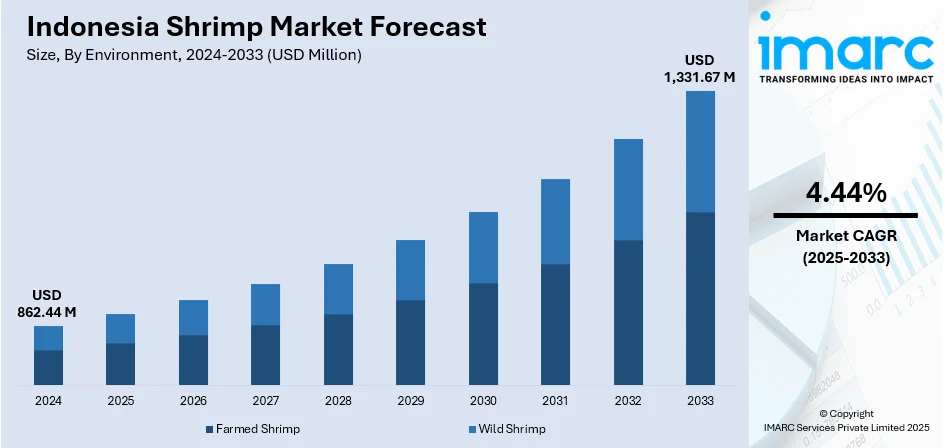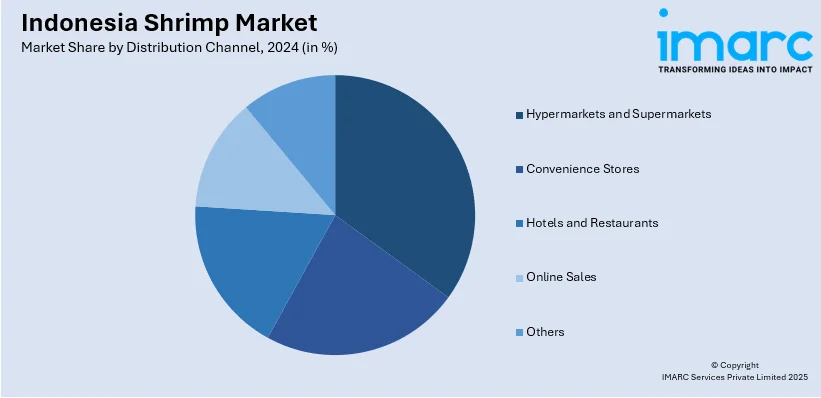
Indonesia Shrimp Market Size, Share, Trends and Forecast by Environment, Species, Shrimp Size, Distribution Channel, and Region, 2025-2033
Indonesia Shrimp Market Overview:
The Indonesia shrimp market size reached USD 862.44 Million in 2024. The market is projected to reach USD 1,331.67 Million by 2033, exhibiting a growth rate (CAGR) of 4.44% during 2025-2033. The market is growing due to advancements in disease management and a shift towards sustainable farming practices. Innovations like early disease detection and eco-friendly farming techniques are enhancing productivity. These trends are expected to strengthen Indonesia shrimp market share in global seafood exports.
|
Report Attribute
|
Key Statistics
|
|---|---|
|
Base Year
|
2024
|
|
Forecast Years
|
2025-2033
|
|
Historical Years
|
2019-2024
|
| Market Size in 2024 | USD 862.44 Million |
| Market Forecast in 2033 | USD 1,331.67 Million |
| Market Growth Rate 2025-2033 | 4.44% |
Indonesia Shrimp Market Trends:
Advancements in Disease Management Technologies
Indonesia shrimp market development is critically driven by continued innovation in disease management, which is crucial in maintaining the growth of the industry. Shrimp farming in Indonesia has historically been challenged by a number of diseases such as White Spot Syndrome and Taura Syndrome, which lead to high losses in both output and quality. Nonetheless, the industry has started embracing new technologies to control these problems, resulting in steadier and more productive farms. Such companies as Nusantics have come up with diagnostic technologies like the ShrimProtect test kit for detecting shrimp disease at the early stages. Using such technology, farmers can respond in time and effectively to avoid outbreaks, lowering the rate of mortality and promoting the overall health of shrimp. Not only do these technologies boost productivity, but they also help Indonesia hold onto competitiveness in the international shrimp market. Furthermore, better disease management practices minimize the economic and environmental effects of disease outbreaks, hence enhancing shrimp farming sustainability in the long run. With the use of advanced tools, farmers can make informed decisions based on data, thus enhancing the quality of the produced shrimp. Widespread use of such technologies is one of the main factors for the steady expansion of Indonesia shrimp market, making the country a leading figure in the world seafood exports.

To get more information on this market, Request Sample
Emphasis on Sustainable Agricultural Practices
Sustainability is increasingly becoming a key driver of the evolution of the Indonesia shrimp market. As environmental concerns become more pressing to people across the globe, the pressure mounts on the shrimp sector to move towards more sustainable means of farming. Traditional farming practices for shrimp tend to degrade the environment, with mangrove cutting and water contamination being common issues. Many farmers, however, are currently moving towards more sustainable means, such as combined mangrove recovery and recycling systems for water. For instance, programs such as the Climate Smart Shrimp Farming (CSSF) program conducted by JALA and Konservasi Indonesia seek to integrate shrimp farming with ecological restoration, with an emphasis on improving productivity while reducing environmental degradation. The approach helps restore important ecosystems, enhance shrimp production, and ensure responsible resource use. Furthermore, in response to increasing awareness among consumers regarding the ecological footprint of their dietary choices, consumers are increasingly demanding sustainably produced shrimp. Consequently, Indonesian shrimp farmers are investing more in sustainable practices and technologies to address these increasing consumer demands. Not only is this transition towards sustainability enhancing the image of Indonesia in the international market, but it also guarantees the future sustainability of the shrimp farming sector. Sustainable shrimp farming is central in guaranteeing the future success and the Indonesia shrimp market growth.
Indonesia Shrimp Market Segmentation:
IMARC Group provides an analysis of the key trends in each segment of the market, along with forecasts at the country and regional level for 2025-2033. Our report has categorized the market based on environment, species, shrimp size, and distribution channel.
Environment Insights:
- Farmed Shrimp
- Wild Shrimp
The report has provided a detailed breakup and analysis of the market based on the environment. This includes farmed shrimp and wild shrimp.
Species Insights:
- Penaeus Vannamei
- Penaeus Monodon
- Macrobrachium Rosenbergii
- Others
The report has provided a detailed breakup and analysis of the market based on the species. This includes penaeus vannamei, penaeus monodon, macrobrachium rosenbergii, and others.
Shrimp Size Insights:
- <21
- 21-25
- 26-30
- 31-40
- 41-50
- 51-60
- 61-70
- >70
The report has provided a detailed breakup and analysis of the market based on the shrimp size. This includes <21, 21-25, 26-30, 31-40, 41-50, 51-60, 61-70, and >70.
Distribution Channel Insights:

- Hypermarkets and Supermarkets
- Convenience Stores
- Hotels and Restaurants
- Online Sales
- Others
A detailed breakup and analysis of the market based on the distribution channel have also been provided in the report. This includes hypermarkets and supermarkets, convenience stores, hotels and restaurants, online sales, and others.
Regional Insights:
- Java
- Sumatra
- Kalimantan
- Sulawesi
- Others
The report has also provided a comprehensive analysis of all the major regional markets, which include Java, Sumatra, Kalimantan, Sulawesi, and others.
Competitive Landscape:
The market research report has also provided a comprehensive analysis of the competitive landscape. Competitive analysis such as market structure, key player positioning, top winning strategies, competitive dashboard, and company evaluation quadrant has been covered in the report. Also, detailed profiles of all major companies have been provided.
Indonesia Shrimp Market News:
- June 2025: Nusantics launched the CeKolam service in collaboration with the Ministry of Marine Affairs and Fisheries. This innovative tool helps shrimp farmers in Indonesia detect diseases early, boosting shrimp farm productivity and ensuring higher-quality production, thus strengthening Indonesia's position in the global shrimp market.
- February 2025: JALA and Konservasi Indonesia launched the Climate Smart Shrimp Farming (CSSF) initiative in Donggala, Indonesia. This sustainable farming program integrates shrimp production with mangrove restoration, enhancing shrimp yields while minimizing environmental impacts. The initiative is expected to enhance Indonesia's shrimp market sustainability and production efficiency.
Indonesia Shrimp Market Report Coverage:
| Report Features | Details |
|---|---|
| Base Year of the Analysis | 2024 |
| Historical Period | 2019-2024 |
| Forecast Period | 2025-2033 |
| Units | Million USD |
| Scope of the Report |
Exploration of Historical Trends and Market Outlook, Industry Catalysts and Challenges, Segment-Wise Historical and Future Market Assessment:
|
| Environments Covered | Farmed Shrimp, Wild Shrimp |
| Species Covered | Penaeus Vannamei, Penaeus Monodon, Macrobrachium Rosenbergii, Others |
| Shrimp Sizes Covered | <21, 21-25, 26-30, 31-40, 41-50, 51-60, 61-70, >70 |
| Distribution Channels Covered | Hypermarkets and Supermarkets, Convenience Stores, Hotels and Restaurants, Online Sales, Others |
| Regions Covered | Java, Sumatra, Kalimantan, Sulawesi, Others |
| Customization Scope | 10% Free Customization |
| Post-Sale Analyst Support | 10-12 Weeks |
| Delivery Format | PDF and Excel through Email (We can also provide the editable version of the report in PPT/Word format on special request) |
Key Questions Answered in This Report:
- How has the Indonesia shrimp market performed so far and how will it perform in the coming years?
- What is the breakup of the Indonesia shrimp market on the basis of environment?
- What is the breakup of the Indonesia shrimp market on the basis of species?
- What is the breakup of the Indonesia shrimp market on the basis of shrimp size?
- What is the breakup of the Indonesia shrimp market on the basis of distribution channel?
- What is the breakup of the Indonesia shrimp market on the basis of region?
- What are the various stages in the value chain of the Indonesia shrimp market?
- What are the key driving factors and challenges in the Indonesia shrimp market?
- What is the structure of the Indonesia shrimp market and who are the key players?
- What is the degree of competition in the Indonesia shrimp market?
Key Benefits for Stakeholders:
- IMARC’s industry report offers a comprehensive quantitative analysis of various market segments, historical and current market trends, market forecasts, and dynamics of the Indonesia shrimp market from 2019-2033.
- The research report provides the latest information on the market drivers, challenges, and opportunities in the Indonesia shrimp market.
- Porter's Five Forces analysis assists stakeholders in assessing the impact of new entrants, competitive rivalry, supplier power, buyer power, and the threat of substitution. It helps stakeholders to analyze the level of competition within the Indonesia shrimp industry and its attractiveness.
- Competitive landscape allows stakeholders to understand their competitive environment and provides an insight into the current positions of key players in the market.
Need more help?
- Speak to our experienced analysts for insights on the current market scenarios.
- Include additional segments and countries to customize the report as per your requirement.
- Gain an unparalleled competitive advantage in your domain by understanding how to utilize the report and positively impacting your operations and revenue.
- For further assistance, please connect with our analysts.
 Request Customization
Request Customization
 Speak to an Analyst
Speak to an Analyst
 Request Brochure
Request Brochure
 Inquire Before Buying
Inquire Before Buying




.webp)




.webp)












